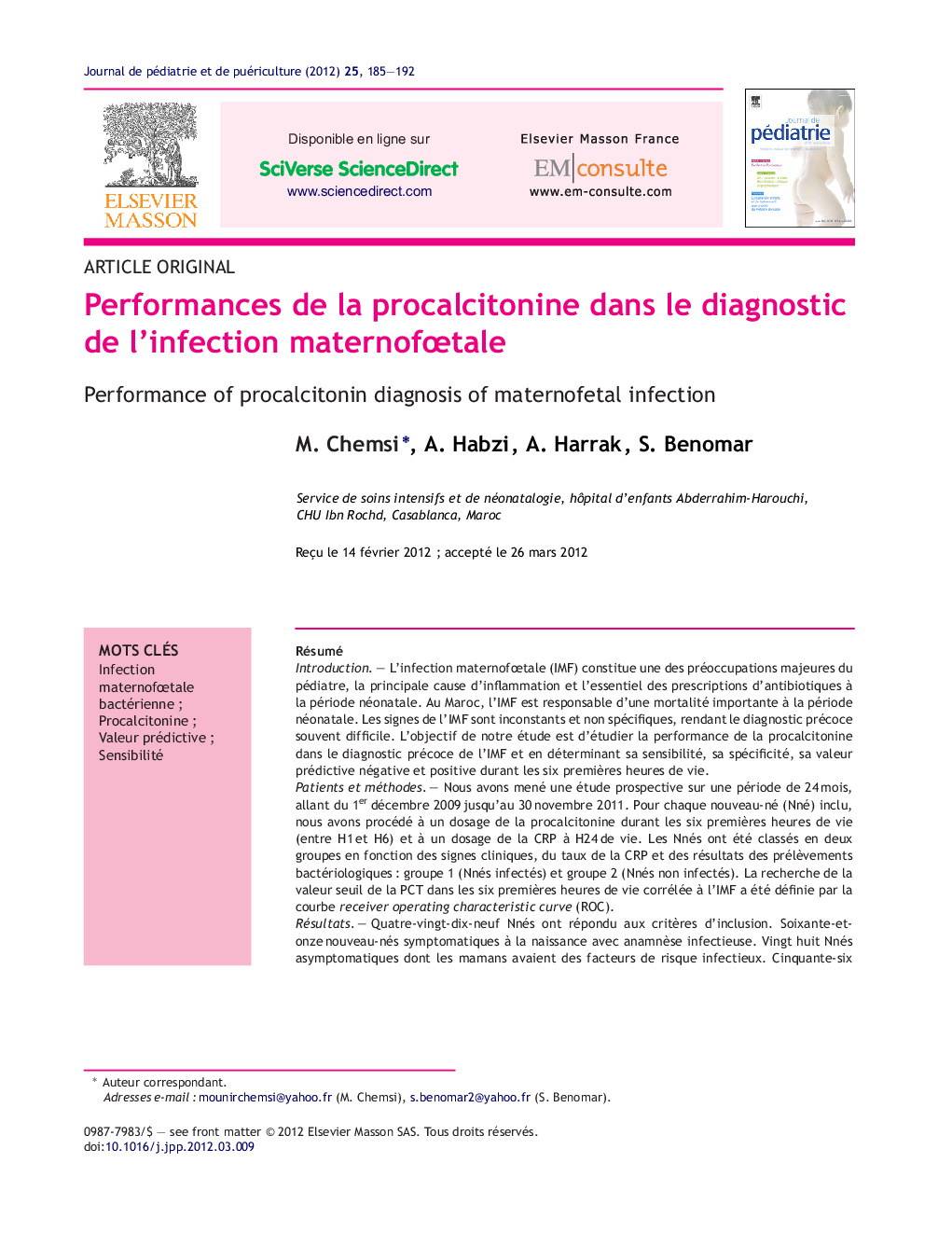| کد مقاله | کد نشریه | سال انتشار | مقاله انگلیسی | نسخه تمام متن |
|---|---|---|---|---|
| 4169904 | 1275427 | 2012 | 8 صفحه PDF | دانلود رایگان |

RésuméIntroductionL’infection maternofœtale (IMF) constitue une des préoccupations majeures du pédiatre, la principale cause d’inflammation et l’essentiel des prescriptions d’antibiotiques à la période néonatale. Au Maroc, l’IMF est responsable d’une mortalité importante à la période néonatale. Les signes de l’IMF sont inconstants et non spécifiques, rendant le diagnostic précoce souvent difficile. L’objectif de notre étude est d’étudier la performance de la procalcitonine dans le diagnostic précoce de l’IMF et en déterminant sa sensibilité, sa spécificité, sa valeur prédictive négative et positive durant les six premières heures de vie.Patients et méthodesNous avons mené une étude prospective sur une période de 24 mois, allant du 1er décembre 2009 jusqu’au 30 novembre 2011. Pour chaque nouveau-né (Nné) inclu, nous avons procédé à un dosage de la procalcitonine durant les six premières heures de vie (entre H1 et H6) et à un dosage de la CRP à H24 de vie. Les Nnés ont été classés en deux groupes en fonction des signes cliniques, du taux de la CRP et des résultats des prélèvements bactériologiques : groupe 1 (Nnés infectés) et groupe 2 (Nnés non infectés). La recherche de la valeur seuil de la PCT dans les six premières heures de vie corrélée à l’IMF a été définie par la courbe receiver operating characteristic curve (ROC).RésultatsQuatre-vingt-dix-neuf Nnés ont répondu aux critères d’inclusion. Soixante-et-onze nouveau-nés symptomatiques à la naissance avec anamnèse infectieuse. Vingt huit Nnés asymptomatiques dont les mamans avaient des facteurs de risque infectieux. Cinquante-six Nnés soit 56,6 % avaient constitué le groupe 1 : 48 cas d’IMF probable et huit cas d’IMF certaine dont un cas de méningite néonatale. La valeur seuil de la PCT (≤ H6 de vie) définie par la courbe ROC et permettant d’avoir une meilleure sensibilité (89,29 %), la meilleure spécificité (100 %) et une bonne valeur prédictive négative (87,8 %) et positive (100 %), était de 1,99 ng/mL permettant de réduire le recours à une antibiothérapie abusive, la durée moyenne de l’antibiothérapie et la durée moyenne d’hospitalisation avec une différence statistiquement significative (p ≤ 0,001) entre le groupe 1 et 2. La valeur moyenne de la PCT (≤ H6 de vie) chez les Nnés ayant une IMF certaine ou probable était supérieure à celles du groupe des Nnés non infectés (14,87 ± 23,79 ng/mL versus 0,73 ± 0,61 ng/mL ; p ≤ 0,001).ConclusionLa procalcitonine est un marqueur innovant de l’infection ayant une cinétique plus précoce que celle des autres protéines de la phase aiguë de l’inflammation. Dans notre expérience, la PCT pourrait constituer un bon marqueur pour le diagnostic précoce d’IMF. Nos résultats attestent au seuil décisionnel de 1,99 ng/mL, durant les six premières heures de vie, d’une meilleure sensibilité, une excellente spécificité et une bonne valeur prédictive négative.
SummaryThe maternofetale infection (IMF) establishes one of the major concerns of the paediatrician, the main cause of inflammation and the main part of the prescriptions of antibiotics in the neonatal period. In Morocco, the IMF is responsible for mortality important for the neonatal period. The signs of the IMF are fickle and non-specific, making the early diagnosis often difficult. The purpose of our study is to estimate our protocol of coverage of the suspect of IMF in newborn children, to study the performance of the procalcitonin in the early diagnosis of the IMF and to determining its sensitivity, specificity, predictive value during the first six hours of life.Subject and methodsWe led a cohort study over a period of 24 months, going from December 1st, 2009 until November 30th, 2011. For every inclusive newborn child, we proceeded to a dosage of the procalcitonin during the first six hours of life (between H1 and H6) and in a dosage of CRP at H24 of life. Two distinct populations were defined based on clinical, biological and bacteriological criteria:group 1 (infected neonates), and group 2 (non infected neonates). We determined the cut-off value correlated with maternofetal infection by analysing the receiver operating characteristics curve (ROC).ResultsThe study had interested 99 newborns, of lower age or equal to H6 of life. Seventy-one newborns children were symptomatic in the birth with infectious anamnesis. Twenty-eight newborns children were asymptomatic whose moms had infectious risk factors. Fifty-six newborns (56.6%) were classified in group 1 with 48 likely infections and eight confirmed infections with neonatal meningitis case. The PCT threshold value (≤ H6 of life) found by the ROC curve with the highest sensibility (89.29%), highest specificity (100%) and the good negative (87.8%) and positive (100%) predictive value was 1.99 ng/mL, making it possible to reduce the abusive use of antibiotics, duration of the antibiotic therapy and the average duration of hospitalization with a statistically significant difference (P < 0.001) between the group 1 and 2. The mean value of the PCT (≤ H6 of life) in group 1 was significantly higher than in group 2 (14.87 ± 23.79 ng/mL versus 0.73l ± 0.61 ng/mL; P < 0.001). The procalcitonin is an innovative marker of the infection having a cinetic more premature than that of the other proteins of the acute phase of the inflammation. In our experience, the PCT could establish a good marker in the diagnosis of infection. Our results give evidence in the decision-making threshold of 1.99 ng/ml, during the first six hours of life, a better sensibility, of an excellent specificity and of a good negative predictive value.
Journal: Journal de Pédiatrie et de Puériculture - Volume 25, Issue 4, September 2012, Pages 185–192